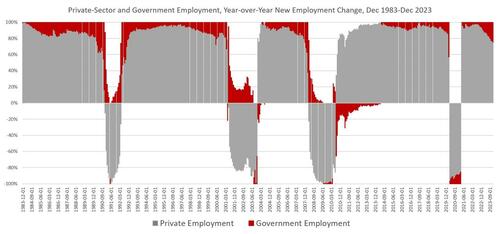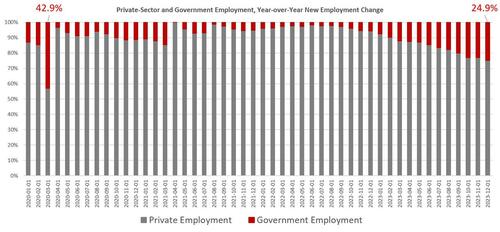Authored by Ryan McMaken via The Mises Institute,
Over the past two years, the Biden administration has repeatedly insisted that job growth is amazing, and that the administration has "created" millions of jobs.
In reality, of course, much of the job growth that did exist was the predictable job growth that came with the end of forced business closures and lockdowns. Job growth was also fueled by rising aggregate demand fueled by runaway growth in government spending. After all, during 2020 and 2021, the regime's easy money policies meant that the central bank and private banks created approximately seven trillion dollars during that period.
Since early 2021, however, the job growth we're seeing has been increasingly fueled by growth in government-sector jobs. In other words, the job growth we do see in the government sector does not represent the result of private investment, saving, or demand. It's not organic economic growth. Rather, these government positions are positions that only exist as the result of wealth transferred from the private sector to the government sector.
Government-funded jobs are not drivers of growth. They are obstacles to growth, as stated by Ludwig von Mises:
...there is need to emphasize the truism that a government can spend or invest only what it takes away from its citizens and that its additional spending and investment curtails the citizens' spending and investment to the full extent of its quantity.
Looking at month-to-month job growth since 2021, the graph shows government jobs as a percentage of all new job growth (according to the establishment survey.) This has accelerated over the past six months as government job growth has comprised from 21 percent to 58 percent over that period. Indeed, over the past year, from December 2022 to December 2023, private sector jobs grew at half the pace of government jobs, with private sector payrolls rising 1.5%. During that time, government payrolls increased 3 percent.
The relationship between government jobs and private sector jobs also can also indicate approaching recessions in many cases.
Here is a graph that shows year-over-year growth in private sector jobs (gray) and government jobs (red), each as a proportion of all job growth. We can see how in numerous cases, the portion of all jobs that is private tends to deteriorate as recessions approach. For example, as the 1991-1992 recession, approached, we see that new government jobs became a larger and larger share of all new jobs during 1990 and 1991.
Government jobs made up about 20 percent of all new job growth in early 1990, but by December of that year, government jobs has provided about half of all new job growth. We can clearly see a similar trend with the lead up to the great recession: private-sector jobs began to collapse as early as late 2006 even though government job creation continued to buoy overall job growth in that period.
During times of strong economic growth, we find that government jobs rarely comprise more than twenty percent of all new jobs.
Since September of this year, however, government jobs has taken up more than twenty percent of all new jobs in each month. In December, government jobs reached 24.9 percent of all new jobs.
That's the largest proportion since the covid panic in March 2020.
Daniel Lacalle has said that the United States is in the midst of a "private sector recession." What he means is aggregate numbers can still show good economic trends—such as job growth—while the private sector is stagnating or shrinking. That is, if government spending and government job creation is robust enough, it will mask private sector weakness in the aggregate statistics.
That may be the trend we are facing right now. The job growth we do see is increasingly being driven by government spending, and not by private investment. Even worse, the government spending we see is largely deficit spending, meaning the economic "good news" is reliant on massive amounts of new government debt.


